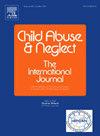不同发展阶段中国学生欺凌受害及其与抑郁症状共现的网络研究
IF 3.4
2区 心理学
Q1 FAMILY STUDIES
引用次数: 0
摘要
霸凌受害及其与抑郁症状的共现已经被研究过。然而,欺凌受害发展的模式以及受害与抑郁症状之间的详细联系仍不清楚。目的通过网络分析,探讨不同发育阶段的霸凌受害行为及其与抑郁症状的共病性。研究人员分析了来自中国全国儿童研究(NCSC)的参与者和数据,包括覆盖中国31个省份的具有全国代表性的样本(N = 23,917, 46.6%的女孩,4至9年级)。方法采用网络分析方法,识别儿童期晚期、青春期早期和青春期中期欺凌受害社区与抑郁症状社区之间的核心节点和边缘,以及连接受害社区和抑郁症状社区的桥梁节点和桥梁边缘。比较三个时期霸凌受害网络和受害与抑郁症状的桥接网络。结果:①“被骂”、“被打、被踢、被推、被推”和“被威胁、被恐吓”分别是青少年后期、青少年早期和青少年中期受害的核心节点;②“被打、被踢、被推、被推”在青少年后期和青少年早期比在青少年中期更容易与“被骂”同时发生。分析还发现了以下一致性:1)一致的桥节点是欺凌受害者的“被说坏话”和抑郁症状的“缺乏友谊”;2)一致的桥边缘是“被说坏话”/“被排斥”与“孤独”/“缺乏友谊”之间的联系。结论关系受害与孤独/友谊缺失之间存在稳定的临界关系,这可能是霸凌受害与抑郁症状共存的基础。共同努力应侧重于查明和处理欺凌行为(特别是关系欺凌行为),以减少受害者出现抑郁症状的风险。本文章由计算机程序翻译,如有差异,请以英文原文为准。
A network approach to understanding bullying victimization and its co-occurrence with depressive symptoms among Chinese students in different developmental periods
Background
Bullying victimization and its co-occurrence with depressive symptoms have previously been explored. However, the pattern of bullying victimization development and the detailed associations between victimization and depressive symptoms remain unknown.
Objective
This study aimed to explore bullying victimization and its comorbidity with depressive symptoms across different developmental periods via network analysis.
Participants and setting
Data from the National Children's Study of China (NCSC) were analysed, including a nationally representative sample (N = 23,917, 46.6 % girls, grades 4 to 9) covering 31 provinces in China.
Methods
Network analysis was applied to identify core nodes and edges of bullying victimization as well as bridge nodes and bridge edges connecting the victimization community and the depressive symptom community across late childhood, early adolescence, and middle adolescence. The network of bullying victimization and the bridge network of victimization and depressive symptoms in these three periods were compared.
Results
The results revealed the following developmental inconsistencies: 1) “being spoken ill of”, “being hit, kicked, pushed, or shoved”, and “being threatened or intimidated” were the core nodes of victimization in late childhood, early adolescence, and middle adolescence, respectively, and 2) “being hit, kicked, pushed, or shoved” was more likely to co-occur with “being spoken ill of” in late childhood and early adolescence than in middle adolescence. The analysis also revealed the following consistencies: 1) the consistent bridge nodes were “being spoken ill of” for bullying victimization and “lack of friendship” for depressive symptoms, and 2) the consistent bridge edges were the connections between “being spoken ill of”/”being excluded” and “loneliness”/”lack of friendship”.
Conclusions
The findings highlighted the stable critical connection between relational victimization and loneliness/the absence of friendships across the three developmental stages, which might be the basis for the co-occurrence of bullying victimization and depressive symptoms. Joint efforts should focus on identifying and addressing bullying (especially relational bullying) to reduce the risk of depressive symptoms for victims.
求助全文
通过发布文献求助,成功后即可免费获取论文全文。
去求助
来源期刊

Child Abuse & Neglect
Multiple-
CiteScore
7.40
自引率
10.40%
发文量
397
期刊介绍:
Official Publication of the International Society for Prevention of Child Abuse and Neglect. Child Abuse & Neglect The International Journal, provides an international, multidisciplinary forum on all aspects of child abuse and neglect, with special emphasis on prevention and treatment; the scope extends further to all those aspects of life which either favor or hinder child development. While contributions will primarily be from the fields of psychology, psychiatry, social work, medicine, nursing, law enforcement, legislature, education, and anthropology, the Journal encourages the concerned lay individual and child-oriented advocate organizations to contribute.
 求助内容:
求助内容: 应助结果提醒方式:
应助结果提醒方式:


